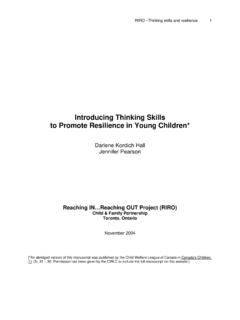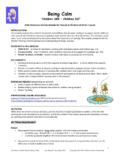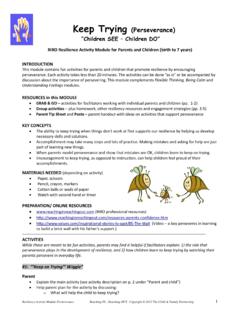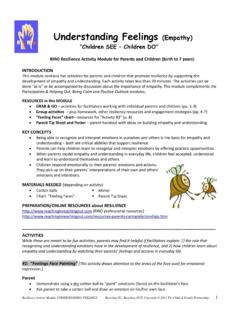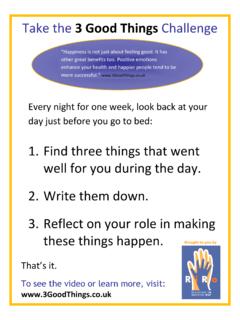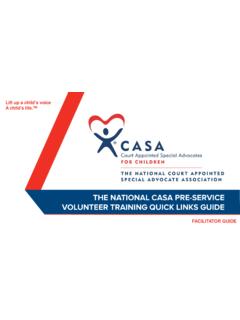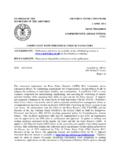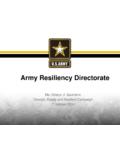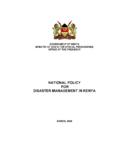Transcription of Flexible Thinking
1 1 Resiliency Activity Module-Being Calm Reaching OUT Copyright 2012 The Child & Family Partnership Flexible Thinking Children SEE Children DO RIRO Resilience Activity Module for Parents & Children (birth to 7 years) INTRODUCTION This module contains fun activities for parents and children that promote resilience by encouraging Flexible Thinking . Each activity takes less than 20 minutes. The activities can be done as is or be accompanied by discussion about the importance of flexibility in supporting resilience. This module complements the Keep Trying and Positive Outlook modules. RESOURCES in this MODULE GRAB & GO activities for facilitators working with individual parents and children (pp. 1-2) Group activities plus homework, other resiliency resources and engagement strategies (pp. 3-5) Parent Tip Sheet and Poster parent handout with ideas on Flexible Thinking KEY CONCEPTS Flexible Thinking a critical ability that supports resilience increases the chances of seeing more solutions and opportunities in all situations.
2 Parents can encourage children to think flexibly by asking questions and giving appropriate choices. When parents take time to think flexibly, children learn to be creative problem-solvers. MATERIALS NEEDED (depending on activity) Paper and pencil (crayon, markers) Story or picture Parent T ip Sheet PREPARATION/ ONLINE RESOURCES (RIRO professional resources) ---------------------------------------- ---------------------------------------- ---------------------------------------- --------------- ACTIVITIES While these are meant to be fun activities, parents may find it helpful if facilitators explain: 1) the role that Flexible Thinking plays in the development of resilience, and 2) how children learn to think flexibly by watching their parents use Flexible Thinking in everyday life. #1: How else can I look at this? Parent Show parent pictures of different situations involving a parent and child (or two or more children; see page 43 of the RIRO Resiliency Guidebook at ).
3 Facilitator and parent come up with three different ideas for what could be happening in the picture. Facilitator points out that they are Thinking flexibly together to come up with different alternatives. Facilitator asks parent to guess: o What could the characters be Thinking ? o What will happen next? Yummy flowers! RAIN drops! 2 Resiliency Activity Module-Being Calm Reaching OUT Copyright 2012 The Child & Family Partnership o What else could happen? o What else could the parent do? What else could the child(ren) do? Parent and child Do activity as above, but ask both the child and parent to answer questions. Encourage parent to ask the child questions about the story. #2: How Many Ways? Parent Parent and facilitator can come up with ideas for: How many ways can the parent ask his/her child to: o come to him/her? o br ush teeth? o be quiet? How many ways can the parent show the child: o s/he is pleased with what the child has done?
4 O s/he loves the child? What could the child be Thinking when the child: o gives another child a toy? o takes a toy from another child? o smiles at the parent? o cries? Parent and child Parent and child take turns figuring out different ways to: o walk from the door to where they sleep o carry water o close the door o fold a piece of paper Ask parent and child (about the activities above) o What else can you do? o What could you do next time? o What other things can you do in more than one way? #3: What can you do Ask parent to think of different things that s/he could do with different objects such as a spoon? a piece of paper? a pebble? (Offer ideas to role model Flexible Thinking .) Ask parent and child to think together of different uses for objects in their home. #4: Parent and infant activities Have parent hold the infant to feed in different ways sometimes facing right and sometimes left. Try different ways to make the baby smile faces, movements, sounds.
5 3 Resiliency Activity Module-Being Calm Reaching OUT Copyright 2012 The Child & Family Partnership GROUP ACTIVITIES NOTE: These activities are designed for professionals and paraprofessionals who have completed RIRO Skills Training Program and who have group facilitation experience. Parent group (no children) Option 1: Give parents a piece of paper and ask them to make a shape (either by folding paper or by drawing). Share all the group members pictures to make the point of how many ways there are to think about this one task. Give everyone a spoon and ask them to think of different ways to use it. Comment on the benefits of Flexible Thinking . Option 2: Show a simple picture of people interacting and ask parents to come up with ideas of what could be happening. o What else could be happening? o What could they do if they were in the picture? Let parents know there are no wrong answers. Comment on the benefits of Flexible Thinking and how they could use the activity with their children.
6 Facilitator may also provide ideas from pp. 1-2 or from Take Home activities (see below). Facilitators suggestions You can also ask parents to think of other ways to verbalize things, , How else could you say that? You can have parents look at different ways to view their children, , Stubborn or Persistent ? Loud or Energetic ? Cranky or Just overtired ? Willful or Natural leader ? Parent-child group Option 1: Give parent child dyads a piece of paper and have them work together to make a shape (either by folding paper or by drawing). Compare all the group members pictures to make the point of how many ways there are to think about this one task. Give everyone a spoon and ask them to think of different ways to use it. Comment on the benefits of Flexible Thinking . Option 2: Show a simple picture of people interacting and ask parents to help children guess what could be happening. o What else could be happening?
7 O What could they do if they were in the picture? Group facilitator may also provide ideas from activities on pp. 1-2 or Take Home activities below. TAKE HOME OPTIONS (for individual parents or groups) Ask parent to use Flexible Thinking to think what else the child learns in an activity. For example, while helping the parent sort clothes, the child can learn types of clothing, colours, or sizes. Ask parent to talk out loud (so the child can hear) while doing daily chores about the choices the parent makes. Encourage parent to develop the habit of asking the child: o What else can we do? o What happens next? o What else do you think could be happening? 4 Resiliency Activity Module-Being Calm Reaching OUT Copyright 2012 The Child & Family Partnership Ask parent to read stories to the child and ask the following questions: o What do you think (character in a book, friend, observed person) is saying to himself inside his head?
8 O What else could be happening? Direct parent to ask child to think of different ways to do the same task or different ways to use same object. (This can be done anywhere it s a good activity when the child is having to wait.) THINGS PARENTS CAN SAY TO THEIR CHILDREN We can do this another way. I wonder what would happen if we tried another way? Let s see what else we can do. If we use the fork to pick up the peas, they stay on better. If we use the spoon to pick up the peas we can pick up more. SUGGESTED OPENINGS/ APPROACHES with PARENT and CHILD Role Role model with parent (examples): o Sally is not coming over to see me. I wonder if she is scared or if she is very interested in the puzzle that she is doing? It could be either, or both! o Today I thought I might be late because the traffic was so bad. I knew that I could not change the traffic, so I tried another route and got here pretty much on time. Role model with parent and child (examples): o You put the yellow block on the blue block.
9 Where else can the blue block go? o Yes! It can go on the red block! / And then where? / Can you ask (caregiver) to help you find another place it can go? Questions you could How often does your child do something in a different way? Does your child try many different ways to do something or does s/he stick to only one way? Things you could The ability to think about events in several ways is related to resilience. Helping your child to use Flexible Thinking in everyday situations increases the chances that your child will be able to see more than one option in difficult situations, and see more opportunities in all situations. Let's look at some ways to help your child think flexibly that you can use with him/her every day. Just like we have to stretch our muscles to keep them from getting stiff and causing problems, all of us need to stretch our Thinking to keep our brain in good working order. Things you could point Pay attention to your own Thinking and be Flexible !
10 Use descriptive feedback with both parent and child during activities. When coming up with options for an object, think of physical things to do as well as imaginative uses. Ask What else ? Ask What s next? Use objects that are at hand to ask What can be done with this? Pick daily activities of family life (like clean up, walking to store, brushing teeth, etc.) and find other ways to do them. Offer flexibility within limits Children still need structure and routine. 5 Resiliency Activity Module-Being Calm Reaching OUT Copyright 2012 The Child & Family Partnership OTHER RESOURCES Books RIRO s online Children s Booklists to support resilience: Selected children s books about helping Asch, F., Moondance (1993) Little Bird helps his friend Bear challenge some negative beliefs and follow his desire to dance with the clouds, the rain, and the moon. (Recommended for children 2 yrs.+) Katie, B.

